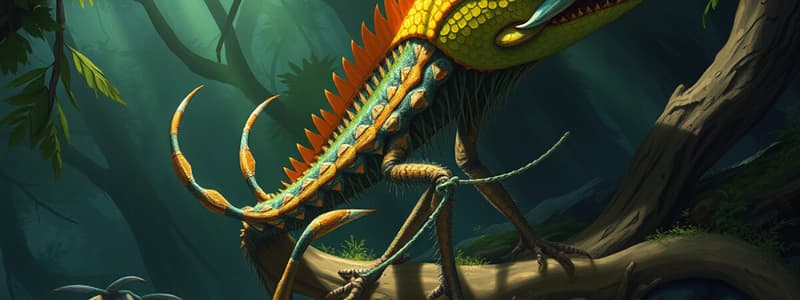Podcast
Questions and Answers
What type of adaptation do short ears of the arctic fox represent?
What type of adaptation do short ears of the arctic fox represent?
- Functional adaptation
- Structural adaptation (correct)
- Physiological adaptation
- Behavioral adaptation
Which adaptation is associated with the bull shark's countershading strategy?
Which adaptation is associated with the bull shark's countershading strategy?
- Structural adaptation (correct)
- Physiological adaptation
- Behavioral adaptation
- Sensory adaptation
Which of the following is a behavioral adaptation of the fennec fox?
Which of the following is a behavioral adaptation of the fennec fox?
- Hunting at night (correct)
- Changing fur color
- Digging burrows
- Puffing up its body for defense
What is indicated by the fact that chameleons can move their eyes independently of each other?
What is indicated by the fact that chameleons can move their eyes independently of each other?
Which adaptation is demonstrated when a panther chameleon puffs up its body for defense?
Which adaptation is demonstrated when a panther chameleon puffs up its body for defense?
What type of adaptation involves changes in an animal's body structure?
What type of adaptation involves changes in an animal's body structure?
Which example best represents behavioral adaptation?
Which example best represents behavioral adaptation?
What characteristic of the penguin’s feet contributes to its adaptation?
What characteristic of the penguin’s feet contributes to its adaptation?
Which of the following is NOT a structural adaptation?
Which of the following is NOT a structural adaptation?
Which animal is specifically mentioned as having structural adaptations?
Which animal is specifically mentioned as having structural adaptations?
The ability to blend in with the environment is related to which type of adaptation?
The ability to blend in with the environment is related to which type of adaptation?
What is a common behavioral adaptation observed in desert animals?
What is a common behavioral adaptation observed in desert animals?
How does a polar bear's fur serve as a structural adaptation?
How does a polar bear's fur serve as a structural adaptation?
What is a primary structural adaptation of the fennec fox that helps it deal with its hot desert habitat?
What is a primary structural adaptation of the fennec fox that helps it deal with its hot desert habitat?
Which behavioral adaptation does the arctic fox exhibit to cope with extreme cold?
Which behavioral adaptation does the arctic fox exhibit to cope with extreme cold?
What is the significance of the color change in the arctic fox's fur?
What is the significance of the color change in the arctic fox's fur?
How do the short ears and legs of the arctic fox function as structural adaptations?
How do the short ears and legs of the arctic fox function as structural adaptations?
What is a behavioral adaptation of the fennec fox that aids in temperature regulation?
What is a behavioral adaptation of the fennec fox that aids in temperature regulation?
Which structural adaptation is NOT present in the fennec fox?
Which structural adaptation is NOT present in the fennec fox?
Which of the following adaptations allows both the fennec and arctic fox to excel at hunting?
Which of the following adaptations allows both the fennec and arctic fox to excel at hunting?
What kind of climate do fennec foxes primarily adapt to?
What kind of climate do fennec foxes primarily adapt to?
Flashcards are hidden until you start studying
Study Notes
Adaptations of Animals
- Penguins possess a thick layer of fat and dense feathers for insulation in cold environments.
- The blood vessels in a penguin's feet are organized in a way that helps regulate body temperature despite extreme cold or heat.
- Some desert lizards exhibit colorful scales which may assist in camouflage or signaling.
Fennec and Polar Bears
- Fennec foxes have sandy-colored fur suited for desert habitats, while polar bears have thick white fur for snow and ice environments.
- Animals like deer, frogs, and lizards can utilize camouflage adaptation to blend with their surroundings.
Types of Adaptation
- Two main adaptability types:
- Structural adaptation: Changes in an animal's physical features.
- Behavioral adaptation: Changes in animal behavior or habits.
- Examples of structural adaptations:
- Thick fur of polar bears for warmth.
- Specialized blood vessel structure in penguin feet for heat regulation.
- Examples of behavioral adaptations:
- Desert lizards seek shade to avoid heat.
- Migratory patterns of various species according to seasons.
Specific Adaptations
- Arctic foxes have short ears and legs, minimizing heat loss, while their burrowing behavior assists in maintaining warmth.
- The arctic fox’s fur changes color from white in winter to brown in summer for better concealment.
- Bull sharks utilize countershading as a camouflage strategy.
Comparisons
- Fennec Fox vs. Arctic Fox:
- Habitat: Fennec fox (dry desert) vs. Arctic fox (Tundra)
- Structural adaptations: Fennec fox has a tan coat and large ears for heat dissipation; Arctic fox has thick, white fur in winter and brown in summer for temperature regulation and hiding.
- Behavioral adaptations:
- Fennec foxes pant to cool down and live in burrows to escape heat.
- Arctic foxes also utilize burrows and eat a varied diet to adapt to their environment.
Notable Features
- Chameleons possess unique adaptations:
- Independent eye movement helps with awareness of surroundings.
- Puffing up their body for defense is a behavioral adaptation.
- The evolution of ear shape in fennec and arctic foxes enhances their hunting capabilities through superior hearing.
Studying That Suits You
Use AI to generate personalized quizzes and flashcards to suit your learning preferences.




